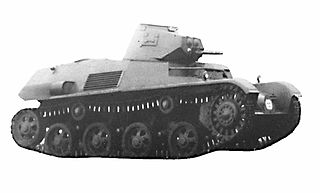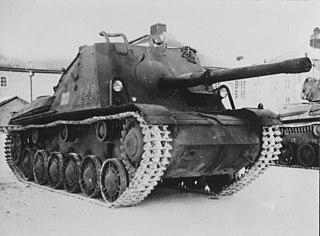
The Stridsvagn 103, also known as the Alternative S and S-tank, is a Swedish Cold War-era main battle tank, designed and manufactured in Sweden. "Strv" is the Swedish military abbreviation of stridsvagn, Swedish for chariot and tank, while the 103 comes from being the third tank in Swedish service to be equipped with a 10.5 cm gun.

The Bofors 37 mm anti-tank gun was an anti-tank gun designed by Swedish manufacturer Bofors in the early 1930s originally for Swedish use. It was exported to several countries during the 1930s of which several bought licences to produce it themselves. The gun was used in several conflicts but most of its fame comes from its use in the Spanish Civil War and the Winter War where it was used very successfully against light tanks and armored cars among other targets. Beyond its use as an infantry gun it was also used as the main armament in several armored cars and tanks such as the Dutch M39 Pantserwagen and the Polish 7TP to name a few. As the armor of tanks was increased during World War II the gun very quickly became obsolete as an anti-tank gun but was still used effectively as an infantry support gun for the entirety of the war, and well into the Cold War. This was due to its high fire rate, great mobility and effective high explosive shells.

The infanterikanonvagn 91, lit. 'infantry cannon wagon 91', was a high mobility assault gun that was developed to meet the operational requirements of the Swedish Army. It was designed and manufactured by Hägglund & Söner and employed common components with the Pbv 302 armoured personnel carrier series. The first prototypes of the ikv 91 were completed in 1969 with production running from 1975 until 1978. In total, 212 were manufactured.

The Landsverk Lynx was a series of Swedish 4x4 armoured cars developed by AB Landsverk just prior to World War II.

15,5 cm bandkanon 1, meaning "15.5 cm (6.1 in) tracked cannon 1", was a Swedish self-propelled artillery vehicle in use with the Swedish Army from 1967 to 2003, developed by Aktiebolaget Bofors. Its product name was Bofors Vagnkanon 155 mm L/50, meaning roughly "Tracked Automotive Gun 155 mm L/50". Bkan 1 was one of the world's heaviest and most powerful self-propelled artillery vehicles in use during its service.

Pansarbandvagn 301, meaning roughly armoured tracked carrier vehicle 301, was a Swedish infantry fighting vehicle used by the Swedish Army. It was designed to carry a squad of 8 fully armed panzergrenadiers into battle and provide direct-fire support for them in combat. The panzergrenadiers could opt to either fight from inside the vehicle through hatches on the roof or dismount the vehicle and fight in its vicinity. The pbv 301 was armed with a Bofors 20 mm (0.8 in) L/70 aircraft gun taken from scrapped Saab 21 fighter aircraft, mounted in an oscillating housing above a rotating cupola. It was fed from 75 round belts stored inside the vehicle. Inside the vehicle were mountings for a variety of infantry weapons and munitions, such as an FN MAG and a Carl Gustaf 8.4 cm recoilless rifle with 9 rounds.

Stridsvagn 122 is a Swedish main battle tank that, like the German Leopard 2A5, is based on the German Leopard 2 improved variant utilizing such newer technology as command, control, and fire-control systems, reinforced armour, and long-term combat capacity. Externally, the vehicle is distinguished from the Leopard 2A5 by the French GALIX smoke dispensers, different storage bins, and the thicker crew hatches.

Stridsvagn 74 was a Swedish light tank in use with the Swedish Army from 1958 to 1984. It was a modification of the older Stridsvagn m/42 medium tank, which was phased out of service in the early 1950s. Instead of scrapping the vehicles altogether, the chassis were used to build a new tank which could be used as a supplement to the newly bought Stridsvagn 81. The turret of the strv 74 was completely new, with a 75 mm high-velocity gun based on an older anti-aircraft gun Bofors 75 mm Model 1929, engines and transmission were modified or changed from the Strv m/42, wider tracks and a separate electrical motor for turret traverse was introduced while retaining manual traverse as a backup.

Stridsvagn m/41 was a Swedish medium tank. A license-built version of the Czechoslovak TNH medium tank, it served into the 1950s.

The Landsverk L-180, L-181 and L-182 are a family of armored cars developed by the Swedish company AB Landsverk during the interwar years. They had a good international reputation for being fast, robust and reliable and were acquired in small numbers by Denmark, Estonia, Ireland and the Netherlands, among others.

The Leichter Kampfwagen II, commonly known as the LK II, was a light tank designed and produced in limited numbers in Germany in the last year of World War I. A development of the LK I, it incorporated a fixed rear superstructure and had two distinct configurations; one variant being armed with the MG 08/15, and the other being armed with a 5.7 cm Maxim-Nordenfelt gun. Its armor was 8 to 14 mm thick, which led to a total weight of 8.75 tons. Power was provided by a Daimler-Benz Model 1910 4-cylinder 55-60 hp gasoline engine, giving a maximum speed of 14 to 18 km/h with range of 65–70 km.

Stridsvagn m/42 was a Swedish medium tank in service in the World War II period. Known by its manufacturer AB Landsverk as Lago II-III-IV, it fielded a 75 mm L/31 gun, the first of its size in a Swedish tank. It entered service with the Swedish Army in April 1943. Modern in design and mobile, a total of 282 were produced.

The Landsverk L-60 was a Swedish tank developed in 1934. It was developed by AB Landsverk as a light tank which included several advanced design features such as torsion bar suspension, periscopes rather than view slits and all-welded construction.

Landsverk L-120 was a light tank designed in Sweden. One tank and one tank chassis was ordered for tests by the Swedish Army in 1936, and one chassis was ordered by the Norwegian Army the same year. The chassis sold to Norway became Norway's first ever tank, after an improvised turret and makeshift armour had been added.

Heavy tank project Emil, known under the cover name of Kranvagn or KRV for short, was a heavy tank developed secretly in Sweden during the early 1950s; Kranvagn, meaning mobile crane, was a cover-name. The intention was to replace the Swedish Army's disparate tank fleet with a tank that could counter the Soviet IS series heavy tanks and be upgraded continuously. The initial design, in 1950, proposed mounting a 10.5 cm autoloader in an oscillating turret. Due to its size, weight and power to weight it was considered by many to be more of a medium tank than a heavy tank.

This article deals with the history and development of tanks employed by the military of Sweden, from the interwar period, and World War II, the Cold War and modern era.

The Pansarvärnskanonvagn m/43 was a tank destroyer developed by Landsverk.

Landsverk L-30 was a Swedish late interwar era medium tank constructed by AB Landsverk for the Swedish Army between 1930 and 1935, featuring welded armour joints and a "wheel-cum-track system", allowing for interchangeable wheeled and tracked propulsion.

The Lvkv m/43 or "Anti-Aircraft Gun Carriage Model 1943" is a Swedish self-propelled anti-aircraft weapon developed by AB Landsverk and Bofors in 1943 out of the need for a tracked anti-aircraft vehicle to protect armored columns from air attack. Based on an elongated version of the hull of an Landsverk L-60 tank and mounting dual Bofors 40 mm L/60 guns the vehicle was adopted into service with the Swedish Army in 1947.



























